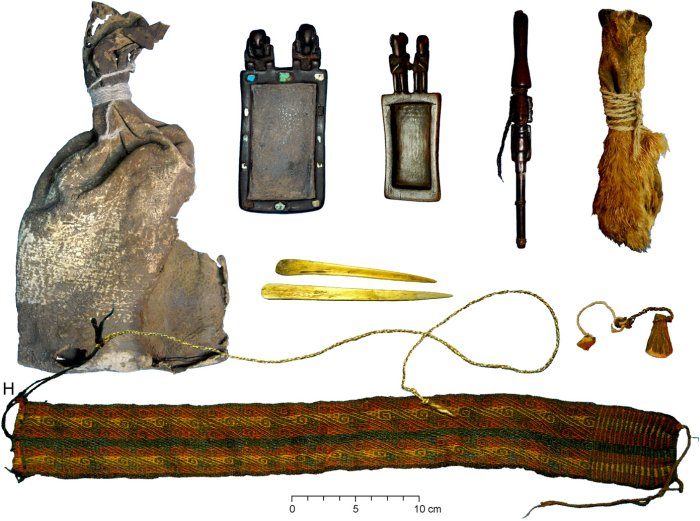
© Miller et al., PNAS, 2019The leather bag and its contents.
Native American shamans living in South America 1,000 years ago had quite the pharmacopoeia in their toolkits.
A shaman's bag found in Bolivia contained a special pouch with traces of multiple psychotropic plants inside, as well as a pretty impressive assembly of paraphernalia.In addition to the pouch, stitched together from three fox snouts, the leather bag contained two wooden tablets for grinding psychotropic plants into snuff, two bone spatulas, a woven headband, and a tube with two human hair braids attached, for smoking hallucinogenic plants.
"We already knew that psychotropics were important in the spiritual and religious activities of the societies of the south-central Andes, but we did not know that these people were using so many different compounds and possibly combining them together,"
said anthropologist Jose Capriles of Penn State.
"This is the largest number of psychoactive substances ever found in a single archaeological assemblage from South America."
Throughout history, humans around the world have used plant-based substances to alter perception, often in religious or ritual contexts. Discerning what these plants were, and how they were used, can tell us a lot about what ancient humans knew about plants, and which plants were culturally important.

Comment: Laura Knight-Jadczyk in Meteorites, Asteroids, and Comets: Damages, Disasters, Injuries, Deaths, and Very Close Calls writes:
- 536 AD: Plague, famine, drought, cold, and a mysterious fog that lasted 18 months
- Student's gold pendant find is worth £145,000 and 'rewrites' Anglo Saxon history
- Oxford University genetic study finds Britons still live in 7th century tribal kingdoms
- Viking city: Excavation reveals urban pioneers not violent raiders
- History textbooks contain 700 years of false, fictional and fabricated narratives
- Middle Ages weren't 'dark', it was an enlightened era - British Library expert
- DNA study reveals fate of ancient Britons
And check out SOTT radio's: Behind the Headlines: Who was Jesus? Examining the evidence that Christ may in fact have been Caesar!